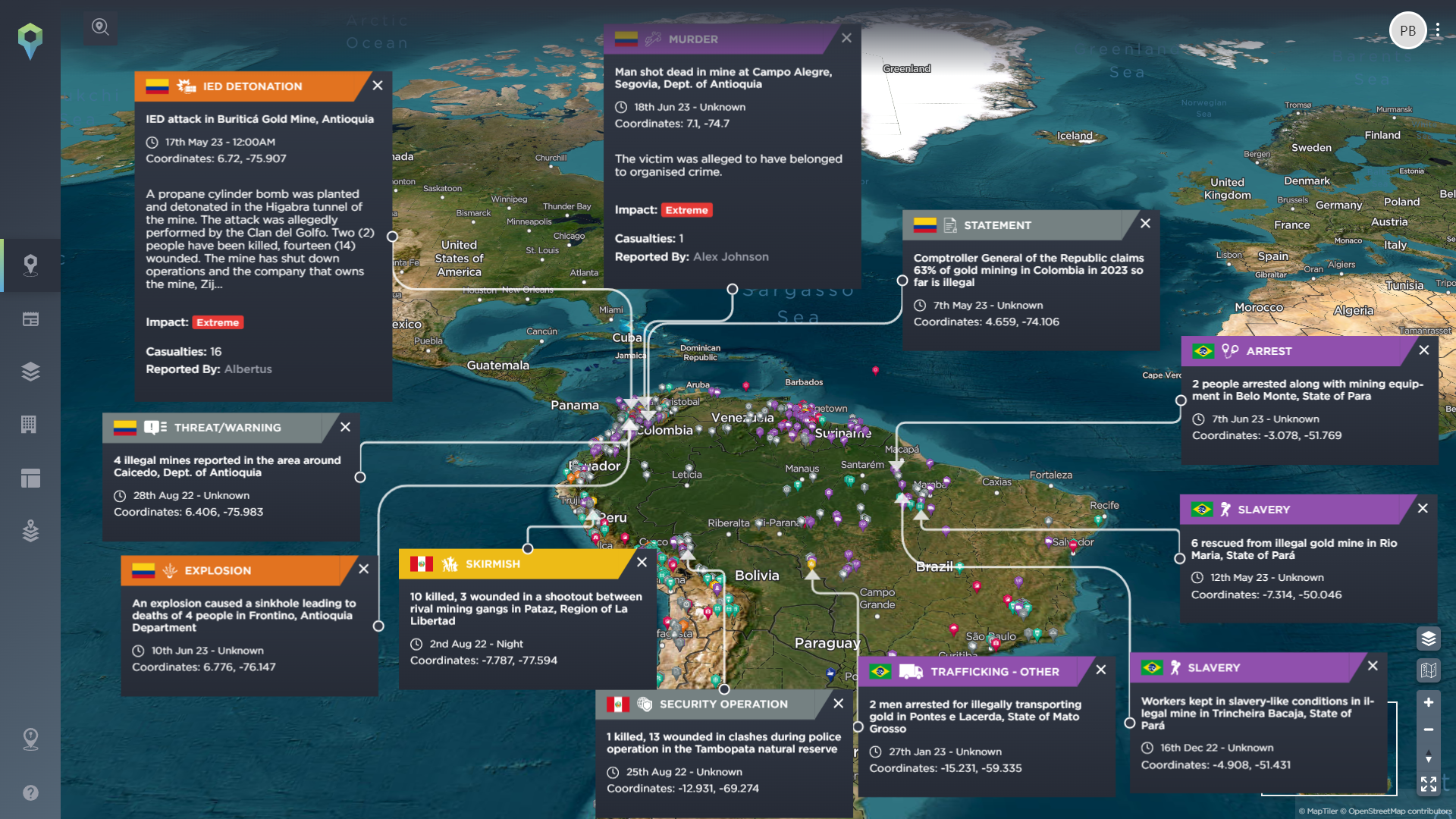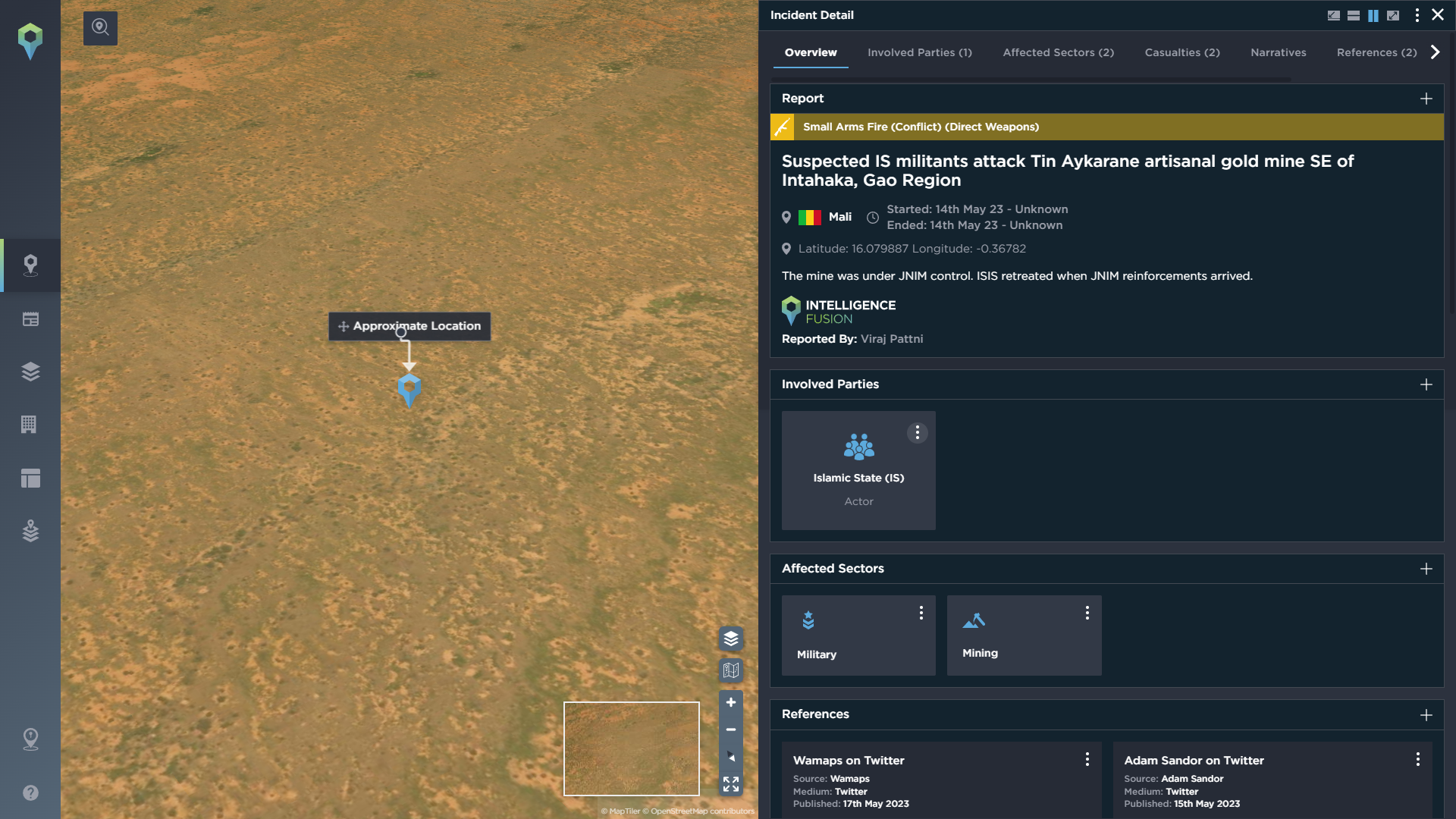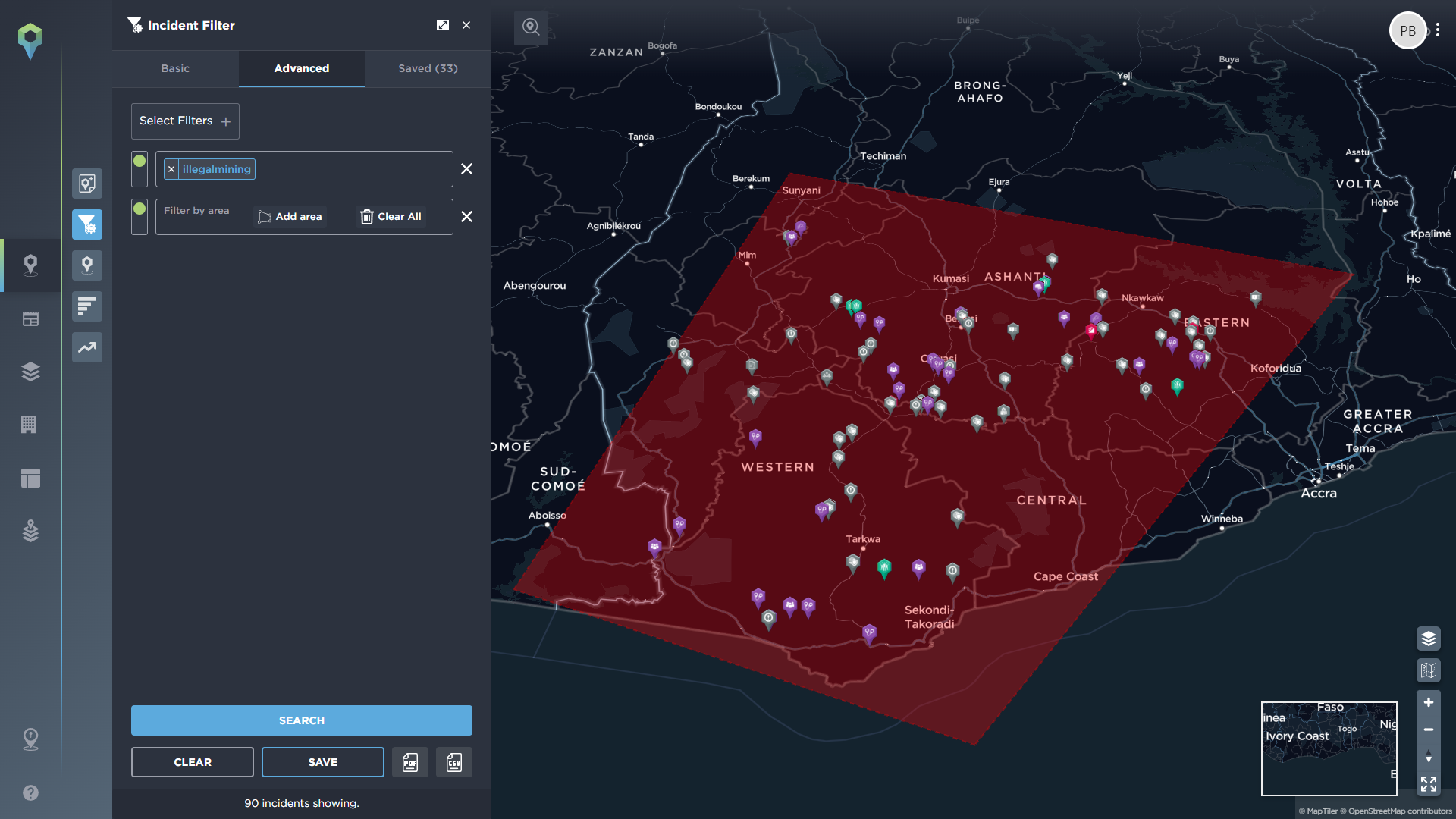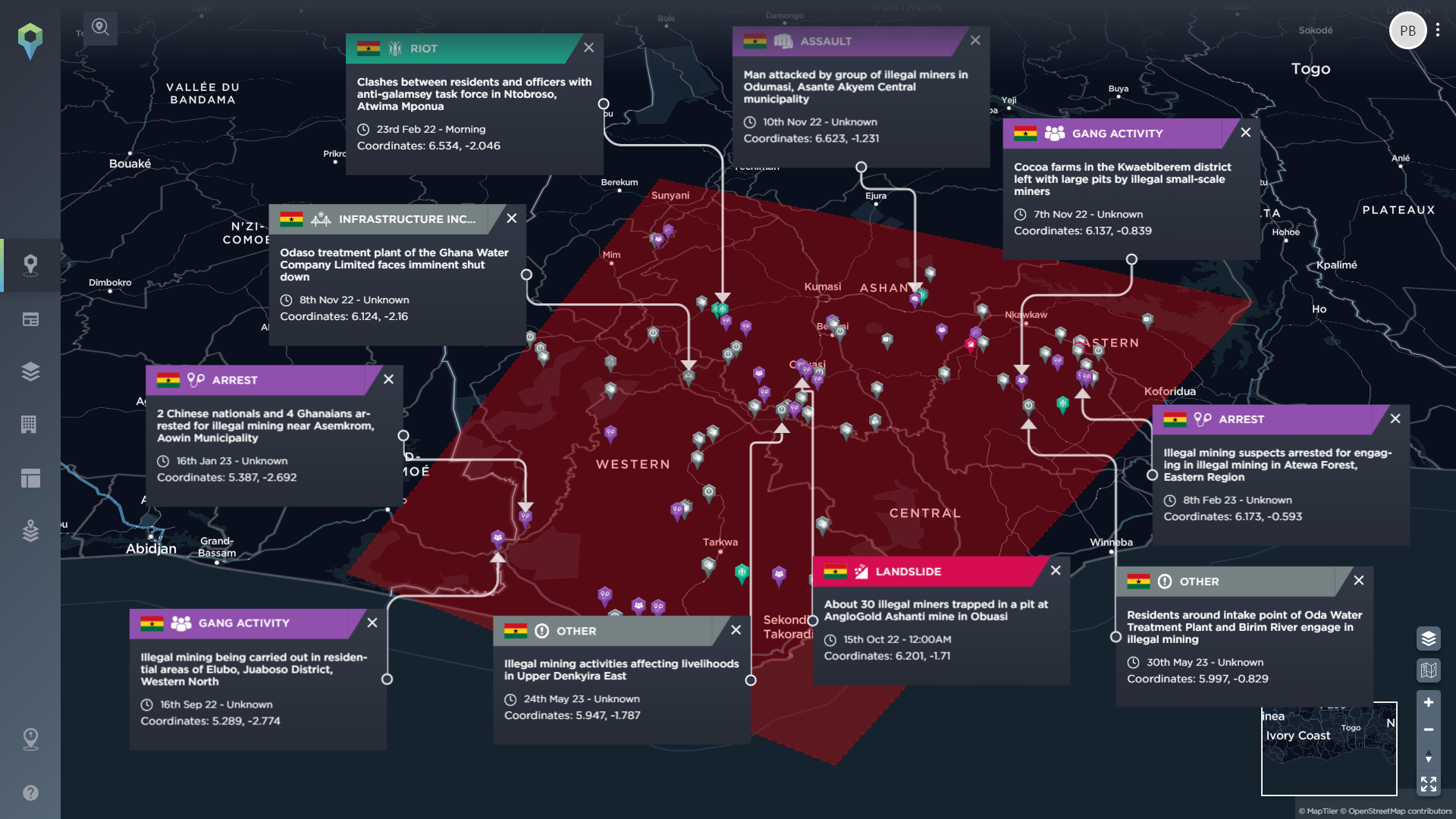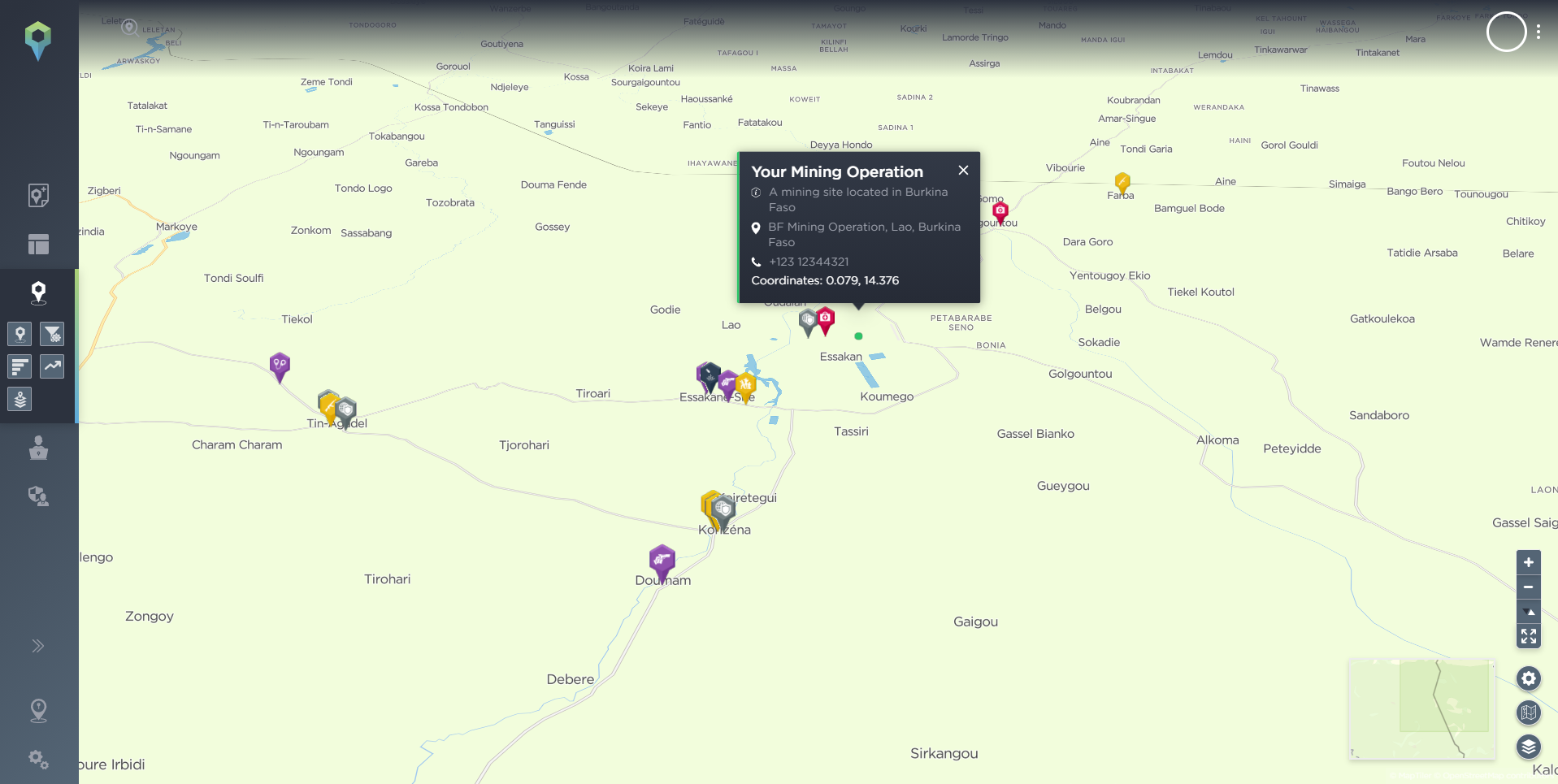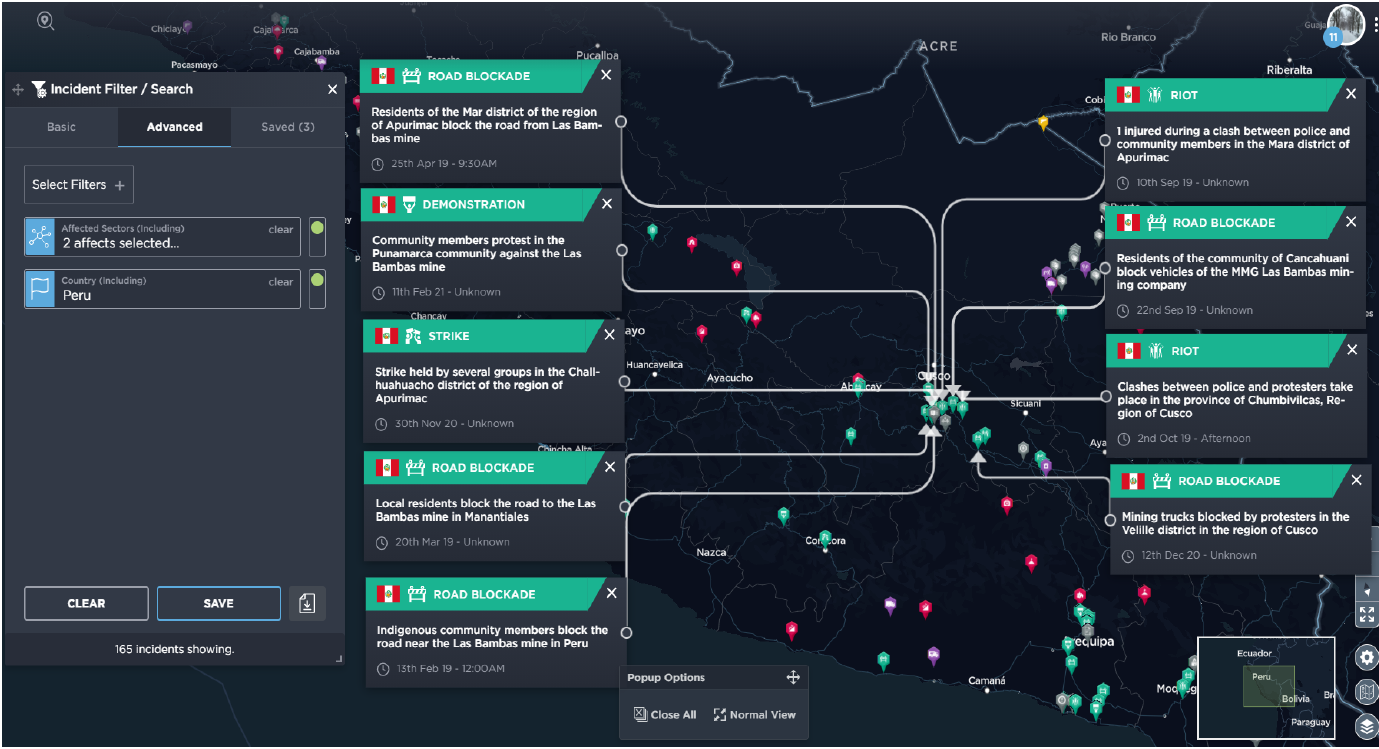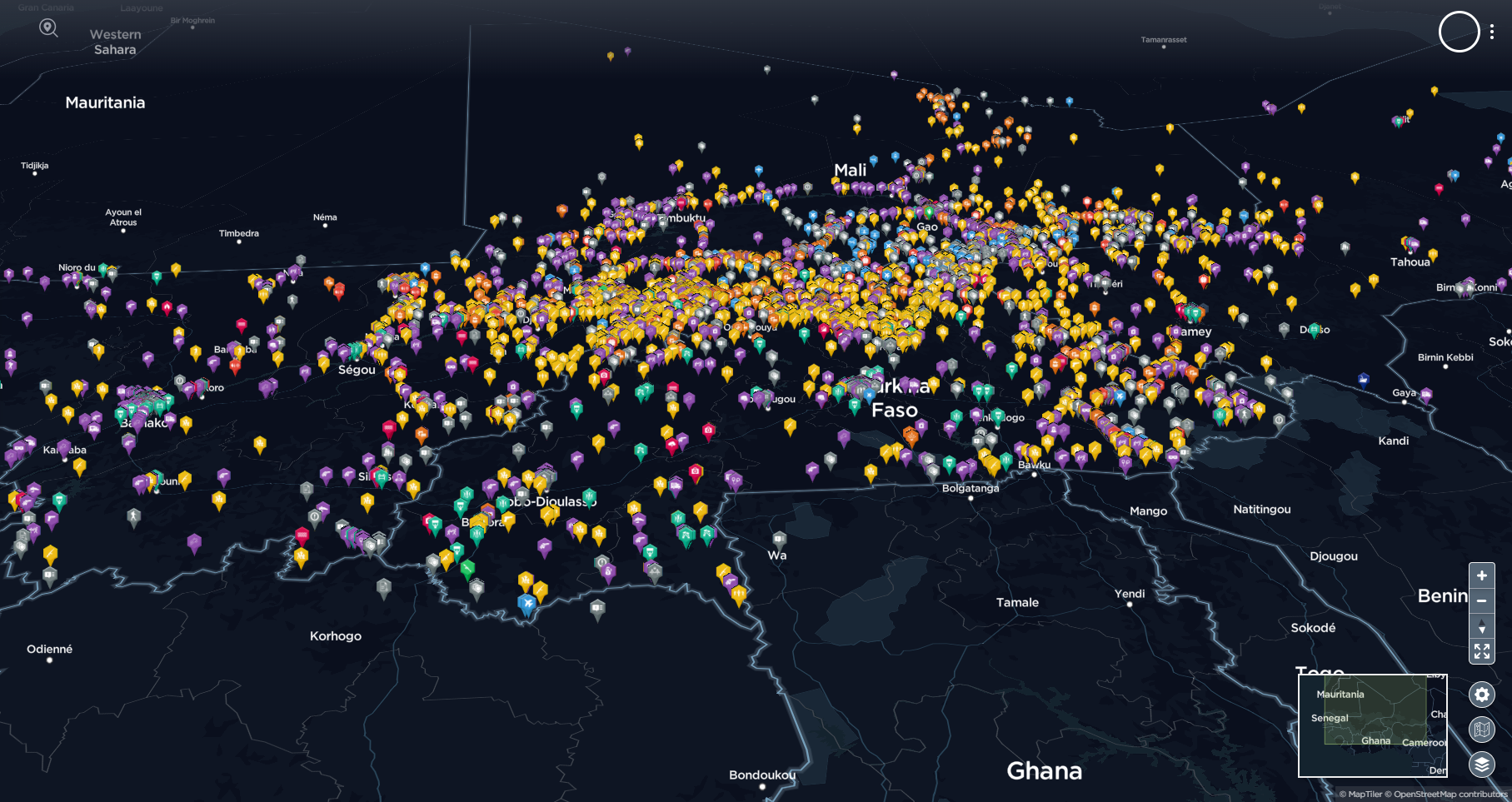Tracking illegal mining using threat intelligence
How to use a threat intelligence solution for tracking illegal mining, and mitigating the threat to your mining operations
Tracking illegal mining is an important part of a risk assessment for mining companies, and with the rapid growth in illegal and artisanal small-scale mining in recent years, being able to consistently track the latest activities – especially near your industrial mining operations – is arguably more important than ever. Rising natural resource prices – for instance, gold, silver or cobalt – have led to a boom in illegal mining activity, particularly in some of the poorest, yet resource-rich, countries in the world. So with this activity becoming increasingly widespread in areas that often overlap with existing industrial mining projects, companies now increasingly need to know how to track illegal mining – and how to mitigate the threat to mining operations.
What are the driving factors behind illegal mining?
Illegal mining occurs in regions that are rich in resources but often poor in terms of development and governance. High levels of poverty, few viable economic opportunities, and the comparative wealth available from illegal mining make it an attractive proposition for millions around the world, often driving internal or even external migration to illegal or ‘artisanal’ mining sites as people look for a way out of economic hardship. This is despite dangerous, unregulated working conditions, handling potentially corrosive and damaging materials, and often high levels of criminality found at the sites and their surrounding areas.
This is another driving factor behind illegal mining – for criminal and illicit groups it can be a lucrative opportunity, whether as an alternative revenue stream to, for example, the narcotics trade, or as a way of funding their armed activities. Many illegal mining sites are therefore operated by criminal gangs, organised crime networks and even terrorist groups. These groups often operate, or have existing ties with, trafficking networks from their narcotics or arms trafficking activities, giving them an already established way in which to smuggle extracted materials out of the countries they’re based in, and smuggle in chemicals such as cyanide and mercury that they can use in extraction.
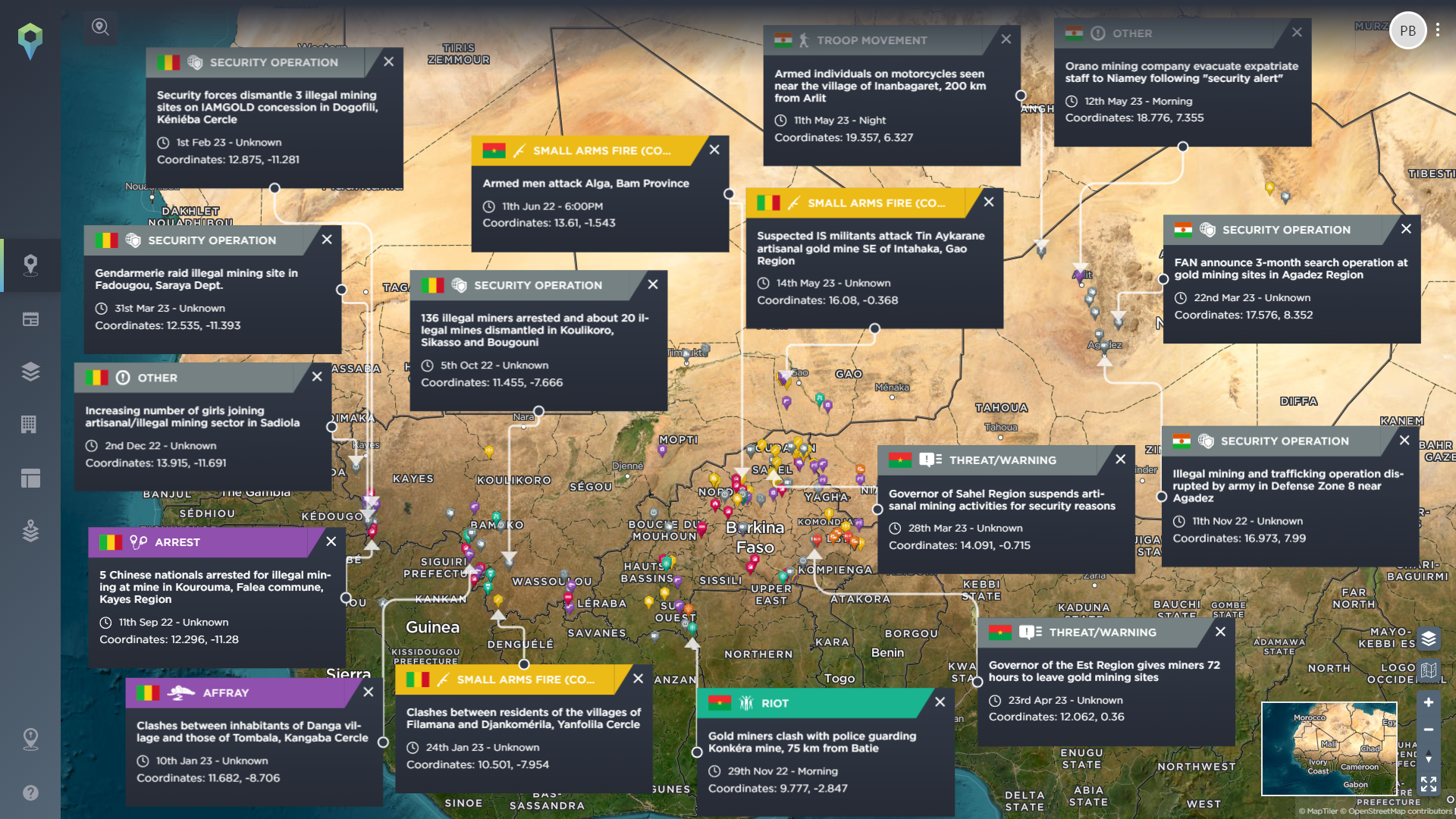
Illegal mining incidents in the Sahel region of West Africa. Many artisanal mining sites are controlled by jihadist groups, while miners also frequently encroach onto industrial mining concessions [image source: Intelligence Fusion]
Why is illegal mining a threat to extraction operations?
Illegal mining is a strong potential flashpoint for conflict when it comes to industrial mining operations. Many illegal mining sites are found in close proximity to or encroach onto the perimeters of industrial mining sites – other times illegal miners trespass onto the industrial sites themselves to mine illicitly on the mining concessions. Repeated encroachment onto mining company sites by this small scale artisanal mining can lead to a shutdown of operations, often for an extended period of time, while security forces of the country or the mine remove the miners – an example of this can be seen in the Brokopondo District of Suriname where the IAMGOLD mine frequently had to pause its operations because of encroaching miners.
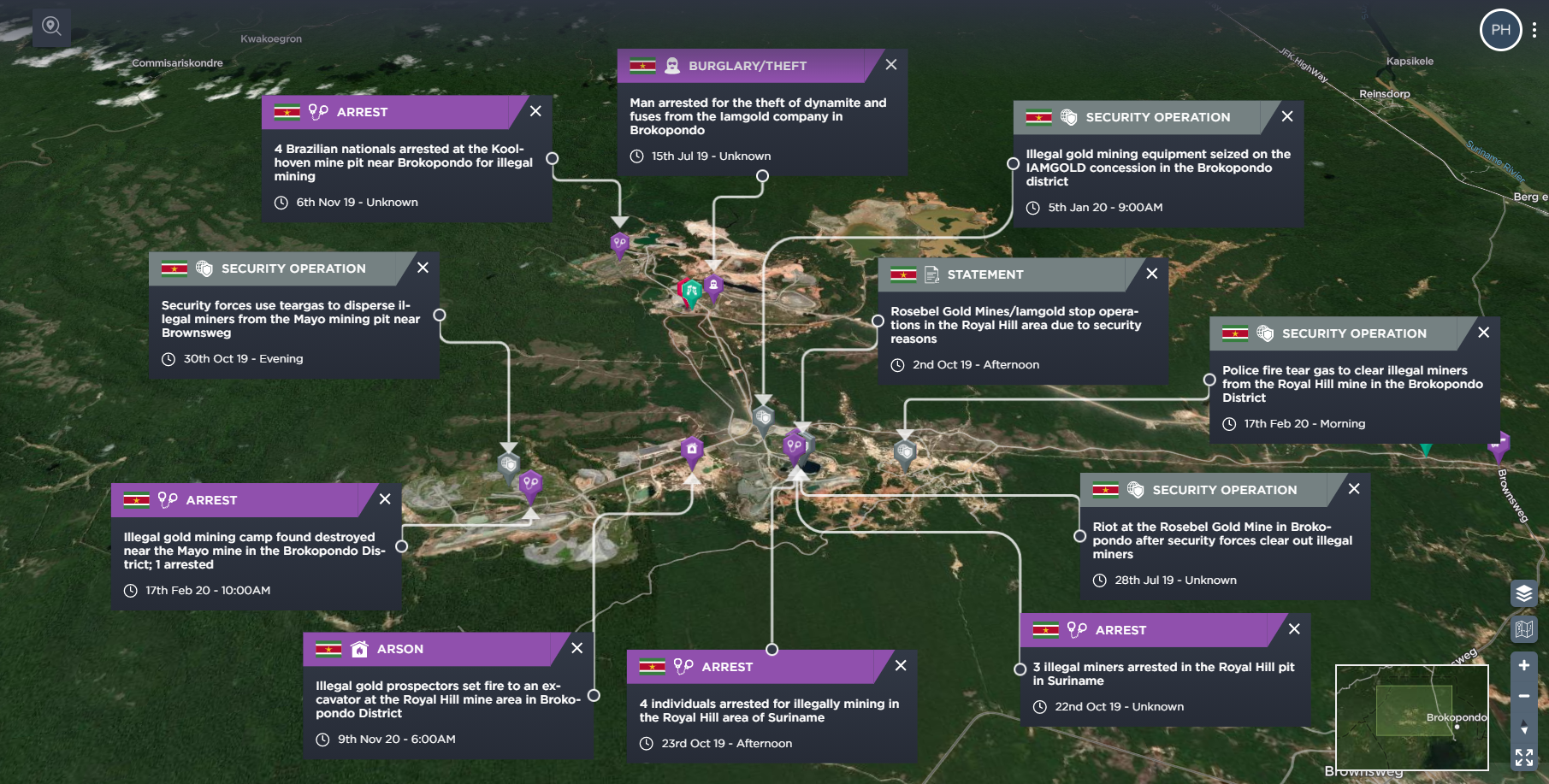
The IAMGOLD mine in the Brokopondo District of Suriname suffered repeated encroachment from illegal miners in 2019 and 2020 [Image source: Intelligence Fusion]
Consequently, there are frequent clashes between illegal miners and site security, or state defence and security forces who have to forcibly evict them. This can cause resentment towards the state and towards the companies themselves, driving anti-mining sentiment among the population if they feel they are being treated unfairly – but it can also have more severe immediate consequences, too, and instances of illegal miners being shot or killed by mine site security are an all too real threat. One such example can be found in Burkina Faso in August 2019 – a security officer shot and killed an artisanal miner at the Youga gold mine, leading to angry locals attacking, ransacking and burning down the mine in response.
In March 2023, illegal miners attacked the Golden Star Wassa Mine in Benso, Ghana, following a clash with security guards which escalated. Police officers were wounded after stopping an attack; however, the illegal miners regrouped and launched another attack, destroying, amongst other properties, 12 vehicles which were set ablaze, including excavators, ambulances and pick-ups.
When illegal miners successfully evade site security though, there can still be tragic consequences: in June 2019, for example, at least 43 people were killed by a landslide at the Glencore KOV open-pit mine near the DRC-Zambia border. The miners were working on the site illegally, and a KCC representative stated that they had apparently ignored warning signs, however this still caused significant reputational damage to the company, and led to numerous protests on the mining concession in the aftermath.
Incidents affecting the mining sector in Africa. Clashes with illegal miners can cause serious issues for mining companies [Image source: Intelligence Fusion]
This potential conflict with the local population, and subsequent damage to community relations, can be a real threat to the viability of an industrial mining operation. As we explain here, failure to win over the local population can cause significant long-term problems for an extraction company, which is why it’s so important to engage with and provide for the community in the area – so if this hard work is undermined by frequent clashes with local miners then it can cause real issues for the mine’s operations. Many local artisanal miners have a sense of ownership of, and entitlement to, the natural resources below their feet – a sense of marginalisation and/or resentment towards large-scale mining operations that might displace them from their lands is, in some ways, inevitable; this can only be worsened if they are frequently, and violently, then coming into conflict with these operations.
Local tensions are not just restricted to illegal miners and industrial mining companies, though – frequently they are between the local community and illegal miners who have come to the region to set up their activity, causing additional instability in the surrounding area which can increase the wider threat to the security of your mining operation. In Brazil, an estimated 20,000 garimpeiros, or ‘independent prospectors’ are believed to be operating in illegal mines in the Yanomami area of the Amazon, Brazil’s largest protected indigenous reserve, causing widespread environmental damage, with reports of miners firing on indigenous groups with automatic weapons, and even claiming COVID vaccines that were intended for the indigenous population, too. In Ghana, reports of Chinese involvement in small-scale gold mining date back to 1998 – since the rise in gold prices from 2008 onwards this has escalated, with Chinese media reporting in 2013 that almost 50,000 Chinese nationals had migrated to Ghana for purposes of small-scale gold mining. In southern Ghana especially, this has led to frequent violent clashes with local villagers from 2012 onwards. Environmental concerns are a particular cause of clashes between locals and illegal miners; because mining activities frequently use chemicals like cyanide and mercury, and because illegal mining sites operate with no real oversight or regulation, often by those with no stake in the local area, the environmental damage caused by these sites can be catastrophic. This can include the poisoning or dredging of river systems, illegal deforestation and damage to soil fertility, worsening the living conditions and poverty levels for those living in the region.
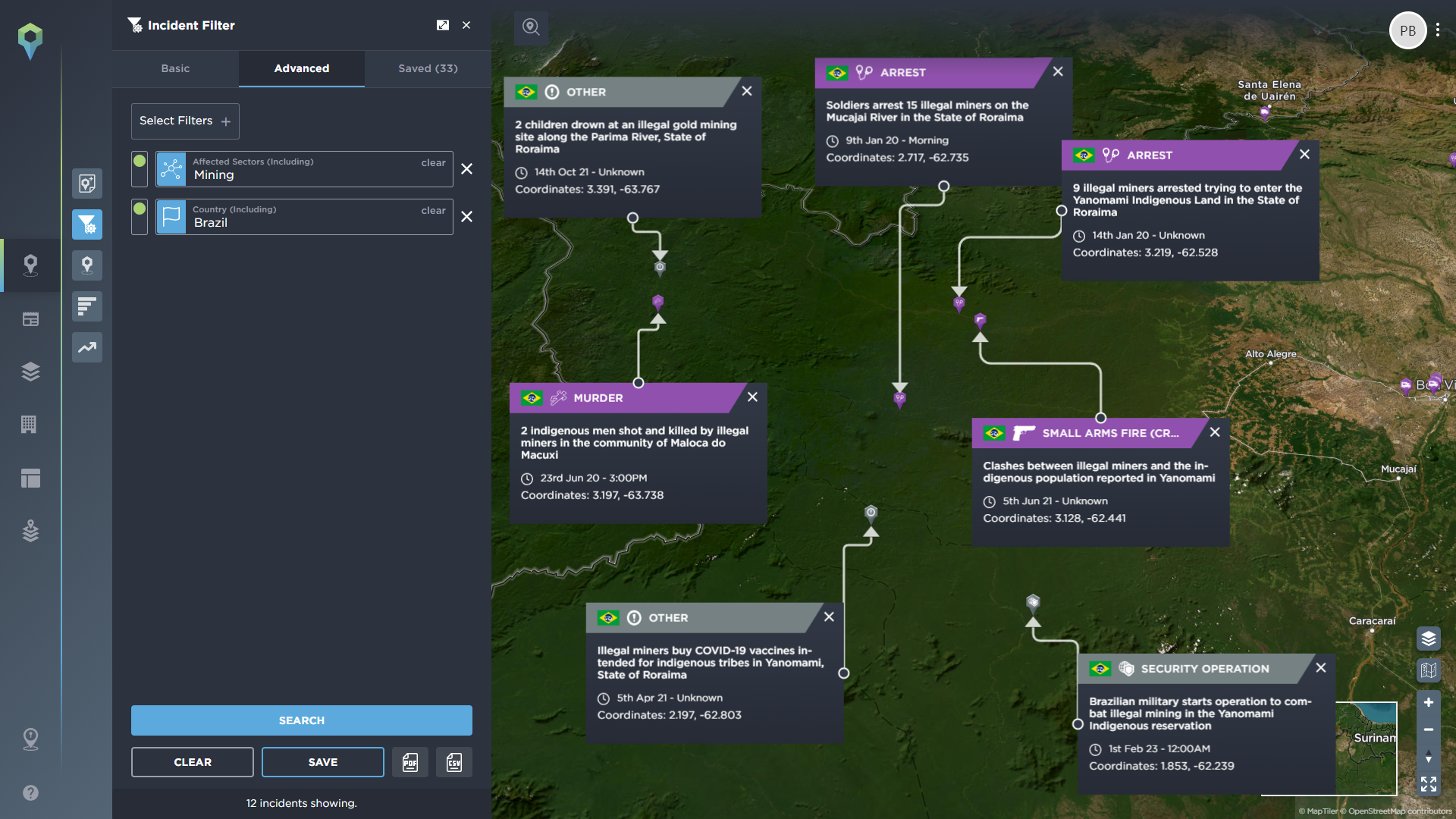
More than 20,000 illegal miners are believed to be operating in Brazil's largest protected indigenous reserve [Image source: Intelligence Fusion]
The other factor to consider is the criminal groups that are attracted to illegal mining. Because these mines are often operated by gangs, organised crime networks or terrorist groups, the profit they generate can fuel instability and insecurity in the region they are based in. Illegal mines in Colombia, for instance, have been known to be operated by FARC dissidents, helping to fund their wider armed activity in the area; drug cartels in the country, and in neighbouring Peru, are also heavily involved in the illegal gold trade, and reportedly now earn more from gold exports than cocaine exports. A June 2020 ISS report on illegal mining in Nigeria states that the criminal ‘sponsors’ of illegal mining operations also fund banditry and cattle rustling in mining communities in order to incite violence among cattle breeders and rearers, causing displacement and creating opportunities for illegal miners to operate. In the central Sahel region of Africa, jihadist groups affiliated with Al-Qaeda and ISIS are reportedly in control of numerous artisanal mining sites in Mali, Burkina Faso and Niger – this helps fund their cross-border terrorist insurgency in the region, fuelling insecurity in an area of significant industrial gold mining activity; in 2019 this directly impacted the SEMAFO gold mining company in Burkina Faso, when a convoy of their workers were ambushed in a complex attack carried out by the Al-Qaeda affilited JNIM group, killing 37 and wounding a further 60. Attacks on mining company convoys, workers and mining sites have become more frequent in the country in the years since. You can read more about the wider security issues facing gold mining operations in the Sahel here. As this shows, by fuelling criminality in the region, illegal mining can therefore exacerbate other wider security threats to mining companies in their areas of operation.
However, even companies not directly involved in these areas of operation are not isolated from risks posed by illegal mining – those companies involved in the downstream mining supply chain face real reputational risks from illegally mined materials entering the supply chain. A July 2021 report from the non-profit organisation C4ADS found that illegally mined gold from the Madre de Dios region of the Peruvian Amazon – linked to widespread deforestation and the contamination of water supplies with mercury – was potentially finding its way to downstream buyers in the US and elsewhere.
How can threat intelligence help you track illegal mining activity?
An effective threat intelligence program is vital for monitoring any activities that could potentially cause issues for your operations, and this includes illegal mining. By monitoring a vast range of open-source content (at Intelligence Fusion, we track an ever-growing list of more than 12,500 sources), you can build up a clear picture of the situation on the ground, helping to feed your security and risk management team with the latest information they need as they monitor the situation. This is even more useful when the information is already accurately geo-located, mapped and verified for you – let’s take a look at the Intelligence Fusion platform to demonstrate this:
Incidents tagged as 'illegal mining' on the Intelligence Fusion platform [Image source: Intelligence Fusion]
When a member of our operations team maps an incident, they can tag it with information that helps us and our clients organise it within our database of more than 1,000,000 historical incidents. Our advanced filtering options then make it easy to find the information that is most relevant to our clients as they utilise the platform. As you can see in the image above, we have filtered for incidents that have been tagged as #illegalmining by one of our analysts, all of which have been accurately placed on our global map, so you can immediately see the areas of the highest levels of activity. This can then be further broken down by other categories, for example by date, country, or even a specific area, so that you see the information that is most relevant to you.
Incidents related to illegal mining in and around the gold-producing region of Ghana, filtered using the ‘Draw Area’ tool on the Intelligence Fusion platform [Image source: Intelligence Fusion]
Clients can set up alerts for filters such as the one above, so that they receive an alert every time a new incident occurs.
So why is this useful? It comes down to a concept known as Situational Awareness – knowing what is going on around you, understanding what this means, and projecting what might happen in the future. Being able to track incidents directly related to illegal mining within your area of operation allows you to build up this situational awareness, giving you a deeper understanding of a potential threat to your activities – so you can then plan accordingly to best mitigate this threat.
Taking this one step further then, as well as tracking incidents directly related to illegal mining, you should also make sure you’re following those incidents that could, in future, drive more people into illegal mining, and potentially worsen the risk to your operations as a result. As we’ve briefly outlined earlier in this article, high levels of poverty and lack of economic opportunity are two driving factors that push people into illegal mining, while it is also a lucrative business for organised crime gangs, and a source of funding for some terrorist groups. Consequently, keeping track of any incidents that might impact these driving factors should also form part of the situational awareness that feeds your security planning.
For instance, the outbreak of the COVID 19 pandemic, and subsequent restrictions and economic impact, was an excellent example of this – with an obvious negative impact on economic opportunities, slowing or preventing foreign humanitarian aid from entering the country as a result of border closures, and the closure of many mass markets that were essential for agricultural trading, there were a number of factors that were likely to push more people into turning to illegal mining as a way to survive. In addition to this, the enforced closure or reduction in workforce in industrial mining operations themselves, as social distancing measures were introduced, may have led to laid off workers turning to the illegal mining industry instead. In December 2020, the UNHCR warned that the pandemic, combined with increased conflict and insecurity in the country, had led to an increase in child trafficking and forced labour in Mali, with the majority of this being linked to illegal mining.
The ongoing global economic downturn and cost of living crisis – caused not just by the impact of COVID-19, but also other factors such as the war in Ukraine – is pushing more and more people into poverty, and will likely make illegal mining an even more vital form of income.
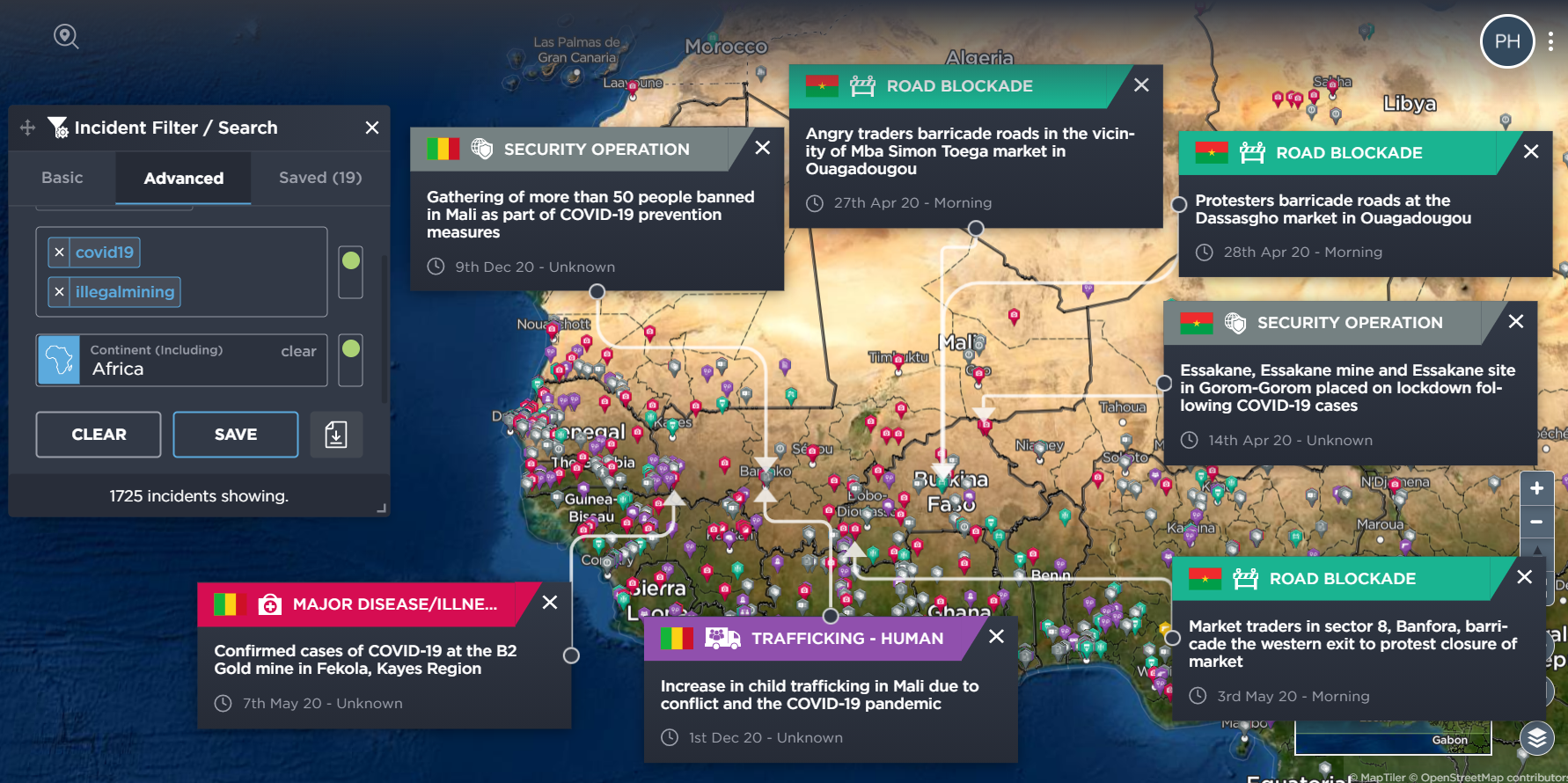
Image shows incidents related to COVID-19 or illegal mining in West Africa. The economic impact of the pandemic may push more people into illegal mining [Image source: Intelligence Fusion]
Additionally, as outlined by the UN in May 2020, it also had the potential to disrupt the narcotics supply chain, at least in the short term – particularly the production of cocaine in countries such as Colombia and Peru. This could have potentially caused organised crime networks with illegal mining operations to ramp up their activities in that sector as a way of overcoming this loss of income.
Finally, by tracking particular groups, for example by using the involved parties filter on the Intelligence Fusion platform, you can see how certain criminal networks are behaving on a wider scale, how their activities might be impacted, and make an assessment on whether they are, or are likely to be, increasing their involvement in illegal mining – and what impact this might have on your operations.
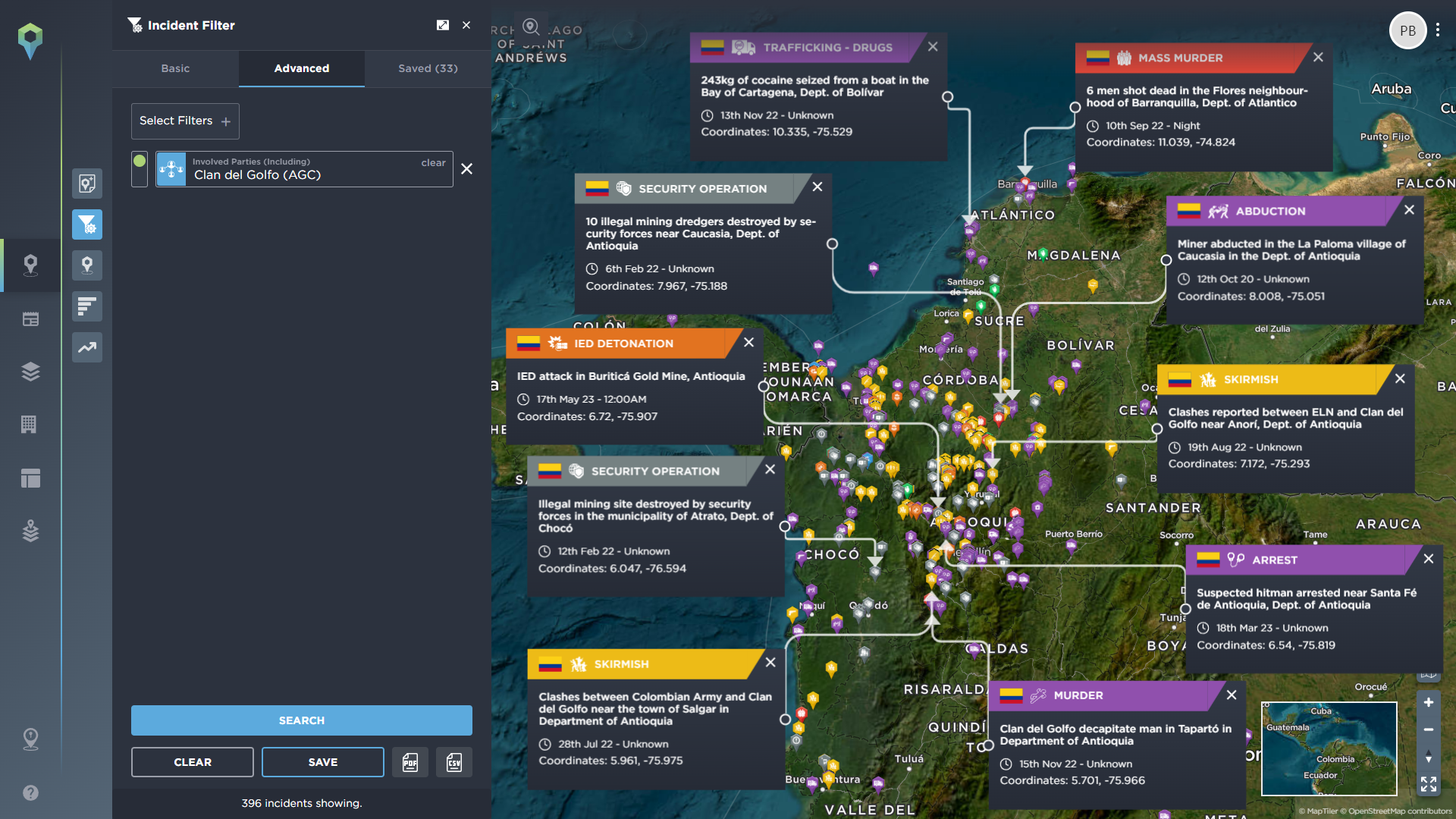
Tracking the activity of the Clan del Golfo in Colombia. The cartel are heavily involved in illegal mining activity in the country [Image source: Intelligence Fusion]
As the illegal mining industry continues to grow, while other forms of employment and economic opportunities shrink as a result of a COVID-19 induced global recession and cost of living crisis, the threats to industrial mining are likely to increase.
It’s clearly important then to track not only illegal mining activity itself, but also any activity that might impact the causes and drivers of illegal mining too. In addition to this, it’s important to remember that illegal mining itself is just one part of a wider threat landscape when it comes to the mining industry. This means a comprehensive threat intelligence program is essential.
Intelligence Fusion has been tracking, mapping and providing in-depth threat intelligence coverage since 2015. With advanced filtering features and accurate, verified threat data that includes over 1,000,000 incidents – with 20,000 new incidents mapped each month – we provide game-changing software that keeps people working in the mining industry ahead of the fast-moving threat landscape.
Take a tour of our software and discuss with a member of the team how we can best meet your needs. Book some time here, or by filling out the form below.
